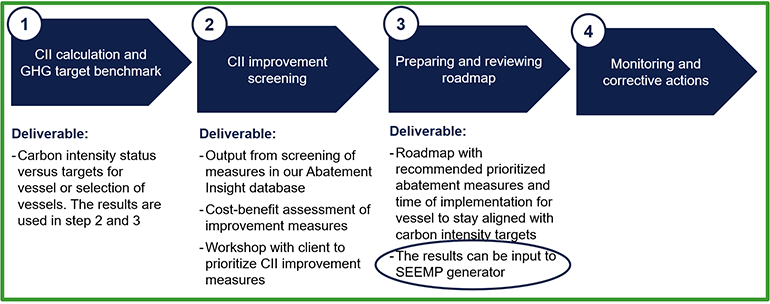Maritime Advisory from DNV
Ship Energy Efficiency Management Plan – SEEMP
Requirements for the SEEMP differ depending on size and trade. The advisory experts at DNV are ready to assist you with an individual SEEMP plan, taking into consideration all variations and the specific needs of your operations.
The benefits of working with DNV on the SEEMP Part III
When developing an energy management plan, learnings from industry best practice is crucial. By partnering with DNV’s advisory experts, you have insights into the most cost-effective operational, technical and alternative fuel abatement measures in the global cluster – supporting compliance in line with your ambitions (regulatory compliance, such as for the CII, or company-specific KPIs).
Depending on the trading pattern and vessel size, the development of an SEEMP follows the workflow shown below, with adjustments made for different requirements to the vessel-specific SEEMP and the SEEMP Part III being the most demanding document to prepare and follow up on.
DNV’s systematic approach to developing an SEEMP, with flexibility for different vessel-specific requirements:

Going beyond SEEMP Part III compliance towards sustainable operations
In a time of transformation, IMO compliance is one side of the coin. Your energy management plan with DNV will also enable you to trade with the lowest possible energy consumption – ensuring sustainable operations, both with regarding emissions and costs.
The SEEMP is a crucial first step towards the comprehensive energy management of any fleet. Based on a rigorous analysis of trading patterns, vessel speeds over time, actual versus desired fuel consumption and so forth, a full-fledged energy efficiency programme should be started and maintained.
It shall encompass technical and operational measures, both on board and in the office, together with training and a goal-driven continuous improvement process.
In case KPIs are not met and rectification action plans must be activated (step 4 in the figure above), we offer the most up-to-date accuracy level of effectiveness of abatement measures suitable for the individual vessel, taking into account already exploited operational optimizations and investments.